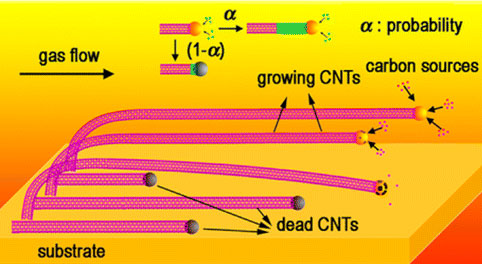| Posted: Jul 15, 2013 | |
Researchers grow half-meter long carbon nanotubes |
|
| (Nanowerk Spotlight) A space elevator based on carbon nanotubes (CNT) cables is one of those ideas from 1950s-style futurism that are so whacky they might just work. There is an annual Space Elevator Conference to discuss progress and a Japanese construction firm even has announced plans to build a space elevator by 2050. These plans mostly depend on carbon nanotubes for manufacturing the up to 100,000 km long tether required to build such an elevator (read more: "To the cosmos by nanotechnology"). And, so far, carbon nanotubes are not up to the job yet. | |
| One of the problems researchers have to struggle with in exploiting the extraordinary mechanical properties of CNTs, for instance for building superstrong fibers or T-shirt-thin ballistic armors, has been the question of how to synthesis CNTs with macroscale lengths and without decreasing areal density. A crucial step for realizing such applications will be the ability to mass-produce carbon nanotubes with meter-scale or even kilometer-scale length and excellent mechanical properties. | |
| In new work, reported in the June 27, 2013 online edition of ACS NANO ("Growth of Half-Meter Long Carbon Nanotubes Based on Schulz–Flory Distribution"), a team of researchers from Tsinghua University in Beijing have found that the growth of ultralong carbon nanotubes could be described using Schulz-Flory distribution, which is very common in polymer science. | |
 |
|
| Illustration of tip-growth of ultralong CNTs. (Reprinted with permission from American Chemical Society) | |
| "The Schulz-Flory distribution successfully explains why the areal density of ultralong carbon nanotubes decreases along the length direction and how to synthesize ultralong carbon nanotubes with high areal density and high ratio of long ones," Yingying Zhang, an Associate Professor at Tsinghua's Center for Nano and Micro Electronics, and co-author of the paper, tells Nanowerk. "Based on our findings, we successfully synthesized half-meter long carbon nanotubes, which, so far, are the longest ones in the world." | |
| Zhang says that the areal density of ultralong carbon nanotubes is relatively low and the highest reported length of them is only 20 cm, which greatly limits their applications. | |
| "Thus, we wanted to explore the reason for the low areal density of ultralong carbon nanotubes and why they cannot grow into longer ones," she says. | |
| According to the team, the main problem during this work has been how to define an effective factor for describing the growth of ultralong carbon nanotubes. After a series of analyses, they found that catalysts play a key role in the growth of ultralong CNTs. Finally, they choose the catalyst activity probability as the key factor to describe the growth of ultralong carbon nanotubes. | |
 |
|
| Mosaic scanning electron microscopy (SEM) images of ultralong CNTs. (Reprinted with permission from American Chemical Society) | |
| "The size and number distribution of ultralong CNTs is controlled by catalyst activity probability, and can be expressed by the Schulz–Flory Distribution," explains Zhang. "The catalyst activity probability plays a key role in the growth of ultralong CNTs and can be tuned by varying the growing parameters. With the optimized conditions, we synthesized half meter-long CNTs with perfect structures through a process with an high catalyst activity probability." | |
| This means that in order to synthesize carbon nanotubes with high areal density and ultralong length, the only way is to improve their catalyst activity probability as much as possible. However, as Zhang points out, the improvement of catalyst activity probability itself is a big challenge for researches. Besides, how to improve the initial areal density of ultralong carbon nanotubes is also a question that needs to be solved. | |
 By
Michael
Berger
– Michael is author of three books by the Royal Society of Chemistry:
Nano-Society: Pushing the Boundaries of Technology,
Nanotechnology: The Future is Tiny, and
Nanoengineering: The Skills and Tools Making Technology Invisible
Copyright ©
Nanowerk LLC
By
Michael
Berger
– Michael is author of three books by the Royal Society of Chemistry:
Nano-Society: Pushing the Boundaries of Technology,
Nanotechnology: The Future is Tiny, and
Nanoengineering: The Skills and Tools Making Technology Invisible
Copyright ©
Nanowerk LLC
|
|
|
Become a Spotlight guest author! Join our large and growing group of guest contributors. Have you just published a scientific paper or have other exciting developments to share with the nanotechnology community? Here is how to publish on nanowerk.com. |
|
